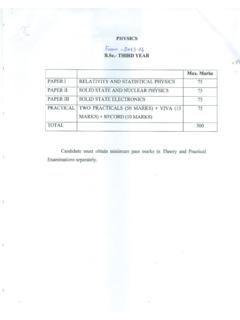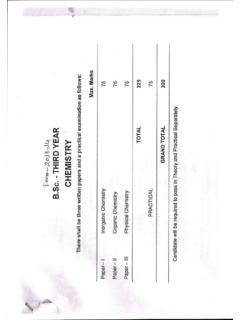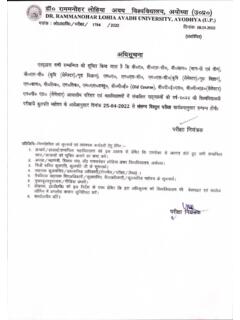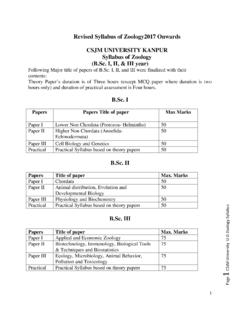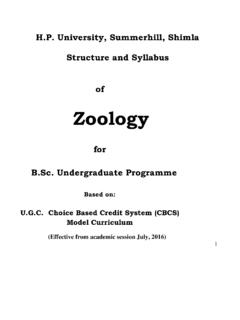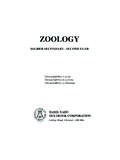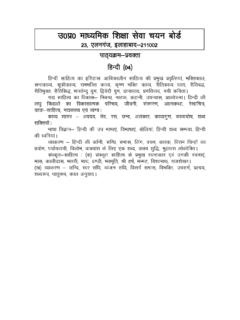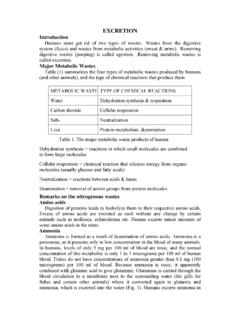Transcription of B.Sc. - First Year Practical
1 1 Syllabus of zoology ( Ist year) SESSION - 2011-12 Following Major title of papers of I Year were finalized with their contents: Theory Paper s duration is of Three hours and duration of practicals is Four hours I Papers Title of paper Max. Marks Paper I Lower Non Chordata (Protozoa- Helminths) 50 Paper II Higher Non Chordata (Annelida- Echinodermata) 50 Paper III Cell Biology and Genetics 50 Practical Practical Syllabus based on theory papers 50 - First Year Practical 1- Dissection (Major) 12 Marks 2- Dissection (Minor) 05 Marks 3- One Temporary Mount 03 Marks 4- One Permanent Mount 05 Marks 5- Cytology & Genetics Preparation/Prepared slides 05 Marks 5- Identify and Comment upon spots (1-10) 10 Marks 6- Viva-Voce 05 Marks 7- Practical class record 05 Marks Total 50 Marks 2 Syllabus of zoology Part I SESSION - 2011-12 There will be three written papers and one Practical examination. Question No.
2 1 in each class will be compulsory & comprehensive based on units I to IV and of short Answer type. This will carry 40% of total marks ( 20 marks in I & II year and 30 marks in III year). There will be two questions from each unit carrying 60% of the marks, of which one question from each unit has to be attempted. Part I Paper I- Lower Non Chordata (Protozoa to Helminths) The habits, morphology, physiology, reproduction, development (in outline) and classification of the following groups of animals including a detailed study of the types given in each: Unit-I Protozoa - Euglena, Monocystis and Paramecium. Unit-II Porifera - Sycon Unit-III Coelenterata - Obelia and Aurelia Ctenophora - Salient features Unit-IV Platyhelminthes - Fasciola (liver fluke) and Taenia (tape worm) Nematehelminthes - Ancylostoma (hook worm) Paper II- Higher Non Chordata (Annelida to Echinodermata) The habits, morphology, physiology, reproduction, development (in outline) and classification of the following groups of animals including a detailed study of the types given in each: Unit-I Annelida - Nereis Unit-II Arthropoda - Palaemon (prawn) Unit-III Mollusca -Pila (apple-snail) Unit-IV Echinodermata -Pentaceros (excluding development) 3 Paper III- Cell Biology & Genetics Unit-I Cell Biology I: Structure and function of cell, Ultra structure of Plasma membrane Unit-II Cell Biology II.
3 Structure and function of cell organelles with special emphasis on mitochondria, golgi bodies, nucleus, ribosome and endoplasmic reticulum. Unit-III Genetics-I: Structure of Chromosomes, Watson & Crick Model of DNA, Differences between DNA & RNA, Cell Division: Mitosis and Meiosis. Mendel s principles of heredity on chromosomal basis, Monohybrid cross, test cross, dihybrid cross, back cross incomplete dominance, Multiple Alleles, Blood group inheritance. Linkage and crossing over, interaction of genes. The role of DNA in heredity. Unit-IV Genetics II: Sex determination, sex differentiation, prenatal detection of genetic diseases (amniocentesis), Sex-linked characters, Genetic diseases and abnormalities, chromosomal aberrations, Eugenics.
4 4 Part I zoology Practical SYLLABUS PROTOZOA (a) Amoeba : Examination of culture. Prepared Slide Amoeba proteus and A. verrucosa. (b) Euglena : Culture examination for Euglena. Prepared slides. (c) Monocystis : Examination of contents of seminal vesicles of Pheretima or Eutyphoeus for different life- history stages and permanent preparation. Prepared slides. (d) Plasmodium : Preparation of blood film (Leishmen s stain). Prepared slides showing the parasites. (e) Paramecium Culture examination. (f) Demonstration of ciliary movements in Paramecium. Addition to mucilage to restrain active movement. Treatment with Methyl green for staining. Feeding experiment with Congo Red and Yeast. Trichocysts (discharged), Prepared slides for structure, binary division and conjugation. (g) Examination of pond water for different kinds of protozoa with special reference to Arcella and Vorticella.
5 (h) Study of prepared slides : Polystomella, Gregarina, Trypanosoma and Noctiluca. ( i ) Examination of rectal protozoans Opalina, Balantidium and Nyctotherus. PORIFERA (a) Sycon General characters Spicules glycerine preparation. Transverse and longitudinal sections-prepared slides. (b) Gemmule of Spongilla permanent preparation. (c) Different kinds of spnge spicules and sponging fibres of Euspongia-prepared slides. (d) Euplectella (Venus,s flower-basket) Spongilla (fresh-water sponge), Euspongia (bath sponge). COELENTERATA (a) Hydra Live specimens. Prepared slides of entire specimens. Longitudinal and transverse sections-prepared slides. (b) Obelia Clolony-prepared slide. Medusa-prepared slide. 5 (c) Aurelia General morphology. Tentaculocyst-prepared slide. Prepared slides and models of life-history stages. (d) Physalia (Portguese man of war), Corallium (red coral), Fungia (Mushroom coral), Madrepora (staghom coral), Pennatula (sea pen), Sagartia of Metridium (sea anaemone) PLATHYHELMINTHES : (a) Fasciola Specimens in situ and prepared slides.
6 Transverse sections and prepared slides. Larval forms-prepared slides. (b) Taenia : Prepared slides of scolex, mature and gravid proglottids and transverse section of mature proglottid. (c) Planaria, Polystomum, Paramphistomum, Schistosma, Echinococcus and Dipylidium Cysticercus (Bladder worm) and Cysticercoid. (d) Examination of type worms of pigeon of fowl in situ (e) Permanent preparation of mature and gravid proglottids of Cotugnia and Raellietina. : NEMATHELMINTHES (a) Ascaris External characters. Dissected specimens of male of female. Transverse section of male and female-prepared slides. (b) Ascaris lumbricoides (from man) specimens Enterobius vermicularisi (from man). Ancylostoma duodenale (from man) prepared slides. ANNELIDA (a) Nereis External characters. Dissected specimens. Parapodium-permanent preparation. Transverse sections-prepared slides. (b) Pheretima External characters. Dissection. Glycerine preparations of setae in situ and brain.
7 Permanent preparations of ovary and septal nephridia. Prepared slides of transverse section through various regions. (c) Heteronereis, Arenicola, Aphrodite, Eutypoeus, Dero, Branchellion, Haemadipsa, Bonellia (female). 6 ARTHROPODA (a) Palaemon External characters; Examination of appendages. Dissections. Glycerine preparation of hastate plate. Permanent and glycerine preparations of statocysts. (b) Periplaneta External characters. Differences between nmale and female. Dissections. Cirulation of blood in the wing of cockroach. Glycerine preparation of mouth appendages, salivary glands and trachea. Permanent preparations of salivary glands, Malpighian tubules, ovaries and testes. (c) Anopheles and Cules Glycerine preparation of mouth parts of male and female. Wings-prepared slides. Life history-prepared slides. Difference between Anopheles and Culex (d) Musca External characters. Glycerine preparation of proboscis (e) Daphnia, Cyclops, Balanus, Eupagurus (hermit crab) Scylla (crab), Sacculina (on crab).
8 Larval forms Nauplius, Zoaea), Lepisma (Silver fish), Schistocerca (locust), Odontotermes (white ant), Cimex (bed bug), Pediculus (louse), Papilio (butterfly), Bombyx (Silk moth), Apis (honey- bee), Polistes (wasp), Camponotus (Black ant), Xenopsylla (rat flea), or Ctenocephalus (dog flea), Thyroglutus (millipede), Scolopendra (centipede). Lycosa (wolf-spider), Lxodes (trick), Limulus (King carb). MOLLUSCA (a) Lamellidens External characters Dissection Permanent preparations of gill lamella. Transverse section through middle region of body-prepared slides. Glochidium (larva) prepared slides. (b) Pila External characters. Dissection. Permanent preparations of gill lamella and osphradium. (c) Chiton, Teredo, Turbinellai (Shankh), Laevicaulis (slug), Doris, Aplysia, Dentalium Nautilus, Sepia and Margaritifera (Pearl Oyster). ECHINODERMATA 7 (a) Pentaceros: External characters Dissected specimens. Pedicellaria-prepared slides.
9 Transverse section of arm-prepared slide. (b) Echinus (Sea urchin), Ophiothrix (brittle star), Holothuria (sea cucumber) and Antedon (feather star). CYTOLOGY (a) Cell-Structure Prepared slides (b) Cell Division Prepared slides (c) Preparation of giant chromosomes (d) Preparation of onion root tip for the stages of mitosis
